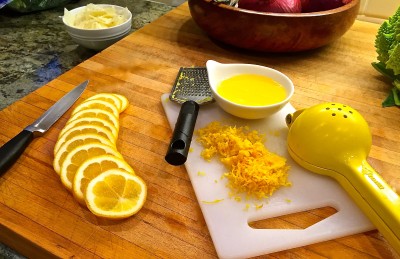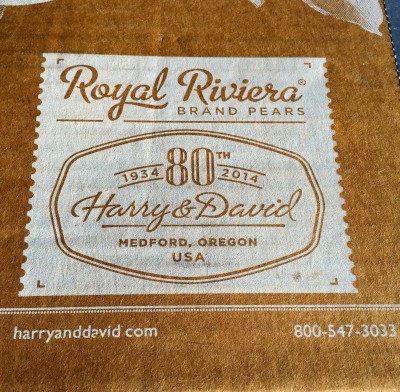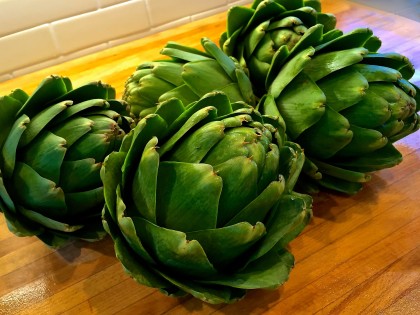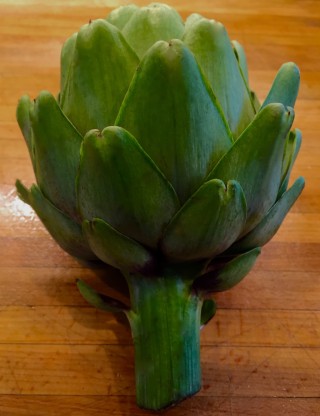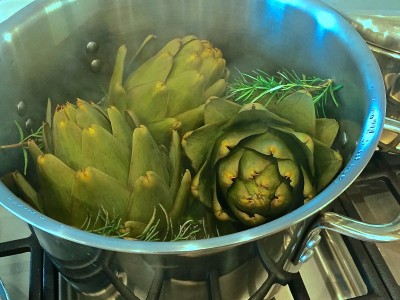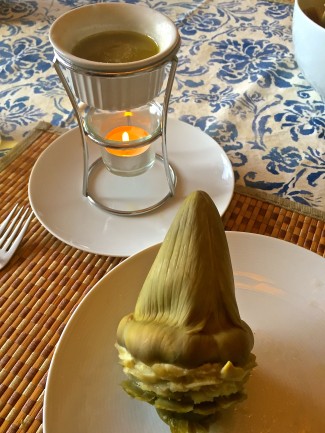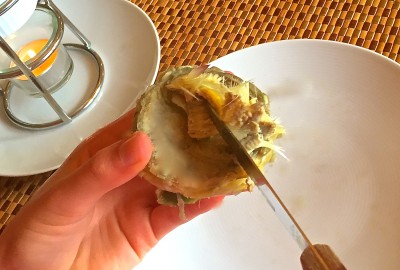Meyer Lemons
We are blessed to have not one, but two Meyer lemon trees in our yard. As the days grow shorter in late autumn, the yellow orbs begin to deepen in color and look like bright seasonal ornaments stealthfully hiding among the deep green foliage. With the passing of each winter day, the lemons grow sweeter, and knowing this makes me feel warm right down to my toes.
Mid-February is the perfect time to begin harvesting the succulent Meyer lemons grown in our region. Meyer’s are sought after in the culinary world, particularly their home-turf in the San Francisco Bay Area. By late February, these fragrant, thin-skinned wonders are popping up in all the foodie hot spots. My local hero, world renowned chief Alice Waters at Chez Penisse has created a winter culinary revolution around Meyer lemons, as well as many other locally grown heirloom fruits and vegetables. (See Jan. 2015 article covering the Black Truffle Event at Chez Penisse, which we had the pleasure of attending this year.)
Why are these lemons so Voovacious you ask? The Meyer is sweeter and less acidic or tart than the ubiquitous supermarket varietals like the Lisbon or Eureka. Both the skin and the pulp possess a lovely, deep yellow hue similar to that of a summer sunflower, making them not only pleasing to the eye, but a culinary winner to the palate as well. I must say, the Meyer lemon is the perfect blend of sweet lemon flavor, divinely mixed with a strong hint of mandarin orange.
Early each spring, we set up shop on the back porch for our family lemon-squeezing gathering. We juice to our hearts content, then freeze the fresh juice in ice trays. Once frozen solid, we place them into zip-lock freezer bags, pulling a few cubes to add to pasta, stir fries, desserts or the cocktail shaker. Meyer lemons are absolutely perfect for making a smooth, sweet lemonade requiring less sugar, or mixed into a zesty lemon mojito. (See our Raspberry Mojito recipe under Le Voov Party Drinks! in the Recipe section.) Meyer lemons are also beautifully paired with fish, Indian dishes or desserts such as Meyer Lemon Pound Cake.
On the nutrition side of things, lemons contain unique flavonoid compounds that have antioxidant and anti-cancer properties. They hold a very low glycemic load, and are an excellent source of B-complex vitamins such as pantothenic acid, pyridoxine, and folates. Further, they carry a healthy quantity of minerals like iron, copper, calcium and potassium. Potassium is a necessary component in controlling a healthy heart rate and proper blood pressure.
Lemons are also an excellent source of vitamin C, which travels through the body neutralizing any harmful, pro-inflammatory free radicals in the blood. Believe it or not, humans and guinea pigs are the only mammals that cannot create their own vitamin C. So, the body requires regular ingestion from external sources like citrus to replenish supplies on a daily basis. Vitamin C is one of many vitamins responsible for supporting a healthy, happy immune system. Helpful hint: Stock up on citrus during cold & flu season! 🙂
As a result of the Meyer’s thin skin, they are quite delicate and perishable. If you don’t have the good fortune of having a tree in your yard, farmers markets are your best bet for a fresh source. Look for shiny, firm, brightly colored orange-yellow skin with strong aromatic qualities to find the most succulent, juicy fruit.
A word of caution, conventionally grown lemons available at supermarkets may be waxed to prevent spoilage or bruising during shipping. Since it’s difficult to determine the source of the wax (animal, insect or petroleum-based), this is yet another reason to look for organically grown, locally sourced lemons, particularly if you plan to zest them.
Citrus season is finally here. Keep an eye out for more recipes and healthy tips concerning these multicolored, juicy spheres in the coming months at Le Voov! We look forward to exploring and sharing what we learn about this diverse selection of sweet citrus juiciness throughout the season. Stay tuned!
Royal Riviera Pears
Each year, for as long as I can remember, our dear friends *Kathy and John have sent us a lovely box of Royal Riviera pears from Harry & David in Oregon. If you have never experienced this amazingly sweet and juicy pear, it is truly one to savor. (Please see my About page for details regarding *The Sisters ? )
Apparently, this varietal was brought to Oregon’s Rogue Valley from France in 1897, where it has flourished ever since. Interestingly, pear trees are one of the most long-lived in an orchard, living up to 250-years. Originally grown to produce hard cider, today they are mainly incorporated into desserts and salads.
Royal Riviera Pears contain low concentrations of lignin, making the flesh particularly soft, creamy, and aromatic, not gritty or sand-like in texture. This makes them ideal for salads or set along side a dry, strong, rather sharp variety of cheese partnered with a loaf of San Francisco French bread. I also find them a lovely pairing (pardon the pun!) on occasion with a small piece of dark chocolate of 70% coca or more to offset the incredible sweetness of the fruit.
A Few Fun Facts About Pears: The Pyrus genus is made up of about 20 species and is related to the apple. Strangely, it is also a distant relative of the rose family (Rosaceae). Today pears are widely grown throughout Europe, America and Asia, yet being an ancestor of the apple, they all originated from a small valley in Afghanistan. Pears are usually picked green as they have the ability to ripen off the tree. So, if you want to know if your pears are ripe, simply test that the flesh at the top stem is slightly soft to find the perfectly ripe pear. Enjoy the splendor!
This year, upon their arrival, the Royal Riviera Pears sang sweetly to Otter-Pop in her bed. She was mesmerized by their chorus…
Artichokes!
Did I mention I love artichokes?
When most people see an artichoke for the first time, they are reminded of the giant man-eating plant ‘Audrey’ from Little Shop of Horrors. Artichokes have thorns that look like dangerous claws on the end of each fibrous leaf. Encountering them for the first time may be a little intimidating, bringing about the cautious apprehension present when attempting to break up a cat fight while naked. It is neither obvious nor intuitive how to approach eating an artichoke for the first-timer. However, if you are fortunate enough to live in an area where artichokes grow, and you are in-the-know on just how to prepare and eat them, they are truly a glorious delight.
While meandering down the coast, we visited the quaint coastal town of Pescadero. Located about half way between Half Moon Bay and Santa Cruz, Pescadero is best known for it’s local artisans, Duarte’s Tavern, Arcangeli Grocery Co (Norm’s Market), and the award-winning goat cheese from Harley’s Farm. (We’ll cover Harley’s Goat Farm in a coming post, so stay tuned!!!
As we wandered down the main drag (Stage Road) sipping our chai tea, I noticed a man carrying a large bag of fresh artichokes. I made a bee-line directly to Arcangeli’s Grocery Co to explore our options for dinner veggies from their bountiful produce selection.
Whenever we are in the Pescadero area, we stop into the Arcangeli’s to pick up a few of our locally-made favorites. This is no ordinary market, and foodies from all over flock to Arcangeli’s for their unique selection of home-baked bread, vinegar, mustard, fresh jam, salsa/hot sauce, marinades and stuffed olives. (They also ship product from their online store!)
Much to my surprise, upon entering Arcangeli’s, I discovered three crates of jumbo-size, locally grown artichokes. Normally, artichokes are just wee-bit larger than a baseball at the base, however in recent years, a jumbo variety has hit the market. These jumbo-chokes are considerably larger than a softball, with menacing thorns rivaling the claws of our feisty Maine-Coon cat Chaz!
As I carefully riffled through the crates, I noticed the sap on the stems of the artichokes were still sticky, meaning they were picked in the last few hours. After deciding upon six beautiful jumbos, I made my way to the checkout line. The two women in front of me were buying several loafs of Arcangeli’s famous garlic herb artichoke bread, which looked and smelled amazing. I knew I would regret it if I didn’t pick up a loaf, but alas, my arms were full of gloriously huge, thorny chokes, so I took a pass on attempting to add anything more.
Once at the register, I was shocked to learn the jumbo artichokes that usually cost $3 – 4/each, were only 75-cents!! Wow, what a great price! Walking back to the car, my mind was busy creating the dipping sauce for our newly purchased dinner side dish. And yep, you guessed it, as we drove north along highway 1, I was kicking myself for not picking up a loaf of that incredible garlic herb artichoke bread. Rats!
Upon arriving home with our prickly score, I cleaned and de-stemmed the artichokes while waiting for the large pot on the stove to come to a rapid boil. In order to avoid discoloration during the cooking process, I add a few lemon slices to the water to prevent oxidation. I also like to throw in a few cloves of garlic and 2 – 3 bay leaves for incredible flavor. Some people take the time to cut off the thorns from the tops of the artichokes prior to cooking, but not me. I prefer to live a bit more dangerously…
I enjoy dipping my artichokes into a garlic butter sauce (see recipe below). However, hollandaise, Dijon aioli, chipotle salsa, creamy pesto, or lemon butter are all delicious options as well.
Note, some prefer to dip their artichoke leaves in mayonnaise, which I find completely distasteful for a myriad of reasons. (Please see my post ‘86 The Mayo‘ for more on this topic.)
In my most Voovacious opinion, the thick, greasy consistency of the mayo completely obliterates the deep, flavorful nuances of the delicious artichoke. Just my 2-cents! 🙂
For our jumbo artichokes, I placed 2-inches of water in the bottom of the pot so they would cook evenly. With the smaller varieties I tend to use a streaming basket. However, in my experience, the larger artichokes require a gentle boil, directly in the water for optimum texture and consistency.
Once in the pot, I turn it down to low and place the cover on the pot tightly. The size and density of an artichoke will determine the exact cooking time. A good rule of thumb to gauge if an artichoke is fully cooked is to give a quick tug to a leaf. If it comes away with little resistance, they’re done! Since artichokes usually take between 25 – 40 minutes to fully cook, I like to use this time to make my Rosemary Dijon & Butter Dipping Sauce to serve up in the White Ceramic Butter Warmers available through our Amazon Store.
Not only is the artichoke an amazing seasonal culinary delight to ingest, they are also rich in essential vitamins such as vitamins C, A, E, K and B, as well as minerals like calcium, iron, manganese, copper, potassium, and phosphorus. As a result of it’s high fiber content, artichokes reduce bad cholesterol (LDL) and raise the levels of good cholesterol (HDL) within the body. Best of all, these over-zealous prickly wonders possess the highest levels of antioxidants in the vegetable world. So eat up and enjoy the healthy benefits of the fabulous artichoke!
How To Eat An Artichoke
Place a large bowl in the middle of the table to collect leaves and fibrous ‘choke’ material during meal. Begin by taking large leaves from the outer edges. Holding the end where the thorns exist, dip into butter sauce. (Don’t worry, the thorns get soft when cooked so they won’t bite your fingers.) After dipping into butter sauce, place the bottom half of the leaf into your mouth, removing the soft, pale green flesh from the fibrous exterior by pulling through your teeth slowly. Caution, you do not eat the entire leaf, rather just the tender interior flesh. Discard the remaining petal.
After you have eaten about half the leaves, you’ll notice the inner leaves get thinner as you work your way towards the center. Gently separate the pointed mound of center leaves from the heart. (Visualize plucking off a gnome’s hat!) Dip and enjoy the tender ends, being cautious not to bite too far up so as to avoid the prickly thorns on the tiny center leaves.
There is a layer of hairy, fibrous material between the leaves and the heart. (Gnome hair…?!!) This is commonly referred to as the ‘choke’ cause that’s what you’ll do if you attempt to ingest it. Gently scrape away the choke with the edge of a butter knife to expose the treasured heart below.
Once the heart is separated from the choke, cut into several pieces and dip into the garlic butter with vigor, making sure to get a few pieces of chopped garlic with each and every savory bite.
Pairing Suggestions
We like to enjoy our artichokes with my Shrimp with Endive, Blue Cheese & Fresh-Cut Tomatoes Salad (see blog Recipe section), accompanied by a fruity Viognier wine and and incredible loaf of garlic herb artichoke bread from Arcangeli’s Grocery Co. If you have a great pairing or dipping sauce to share, please feel free to share it with us!
To quote the lady from the Artichoke Festival in Castroville, “Eat your heart out!”
Voovacious Helpful Hints: Eating artichokes on a first date should be reserved for the confident individual, as glorious garlic butter dripping down your chin is common, as is green fibrous material lodged within your pearly whites. (Be sure to have dental floss on hand for the after party!) You’ll also require several napkins if you’re truly embracing this Voovelicious epicurean experience…
Other Voovacious Thoughts
- Do not place any portion of the artichoke in the garbage disposal unless you’re looking to get a visit from a handsome plumber. (Just compost it or discard into trash, trust me, I speak from experience…) 😉
- California Artichokes (Globe artichoke) are related to the thistle plant and should not be confused with Jerusalem artichokes (also referred to as sun chokes or earth apples), which are a variety of Sunflower. Grown for it’s tuberous roots, Jerusalem artichokes are considered a root vegetable like carrots and beets.
- If you are lucky to find ‘frost-kissed’ artichokes, don’t be dissuaded by the browned, burnt edges. Strangely, they tend to be sweeter than their non-frost-kissed brethren. (Nope, I haven’t any idea why this would be the case…)
- In case you’re in a rush or just ridiculously excited about ingesting this cousin to the thistle, artichokes can also be cooked in 15 – 20 minutes in a pressure cooker!
- Every May the Artichoke Festival takes place in Castroville (Monterey County), California. They have a parade, cooking demos, tours of local artichoke farms, a car show, as well as artichoke-themed art & wine tasting from the famous Central Coast region. The Artichoke Festival takes place at the Monterey County Fair & Event Center. (Open daily 10 AM – 6 PM) Join in the fun of celebrating our very favorite thistle!



